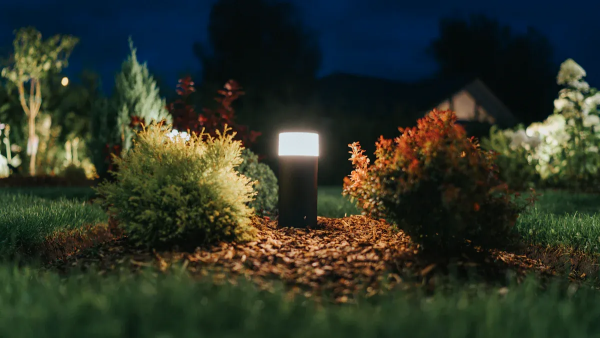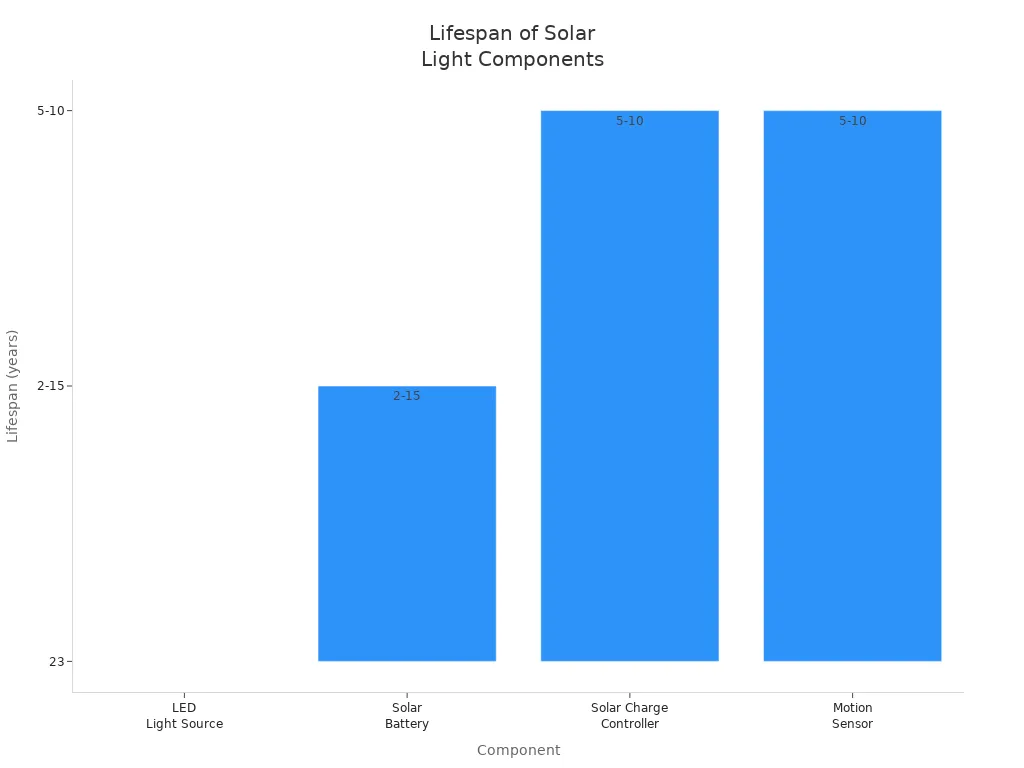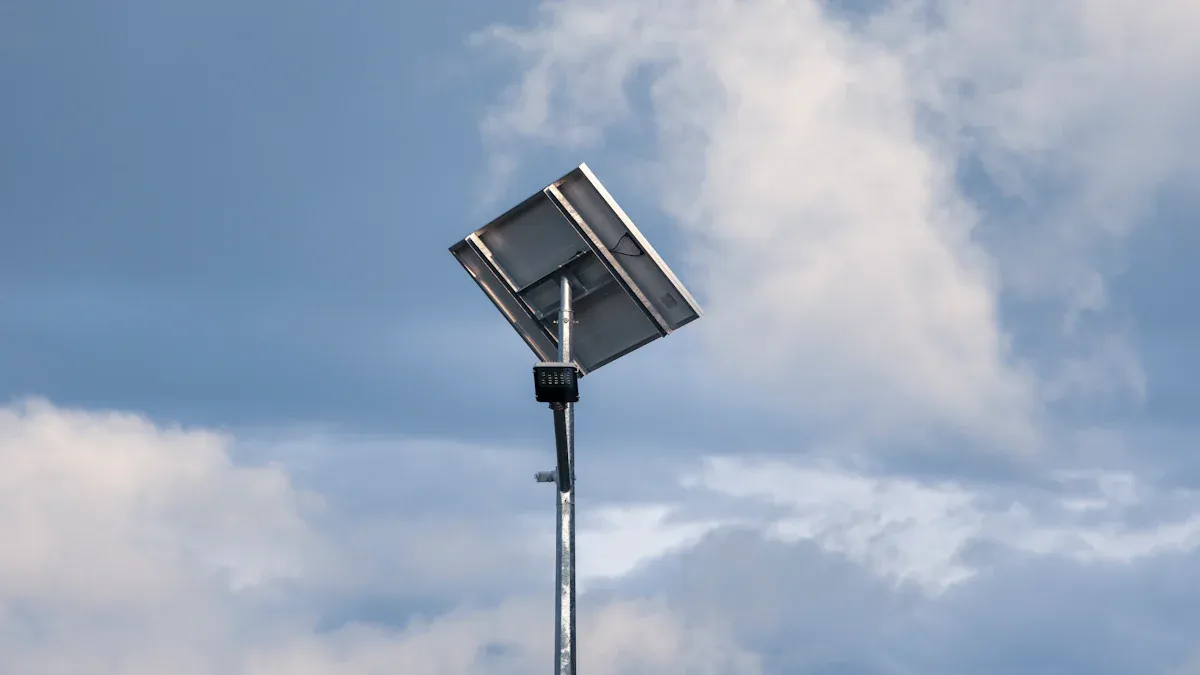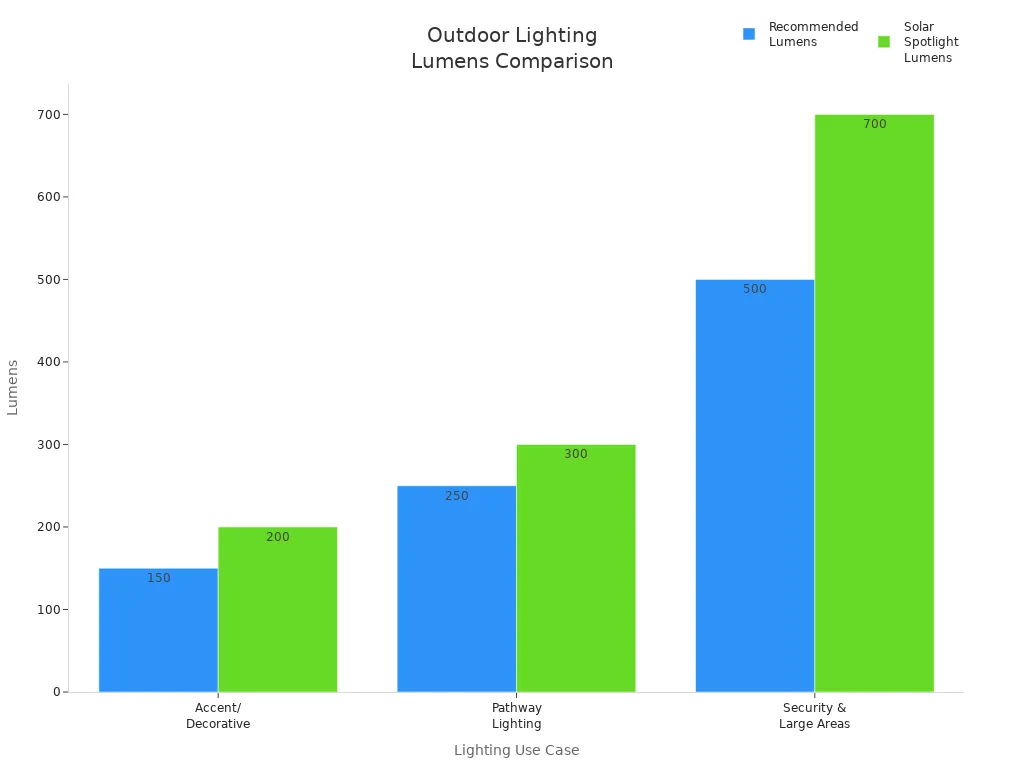
Choosing between solar spot lights and LED landscape lighting depends on what matters most. Take a look at the key differences:
| Aspect | Solar Spot Lights | LED Landscape Lighting |
|---|---|---|
| Power Source | Solar panels and batteries | Wired low voltage |
| Installation | No wiring, easy setup | Needs wiring, more planning |
| Performance | Sunlight-dependent, may vary | Consistent, reliable lighting |
| Lifespan | Shorter, frequent replacements | Longer, can last 20+ years |
Solar Lights work great for simple, cost-effective setups, while LED landscape lighting shines for lasting, customizable designs.
Key Takeaways
- Solar spot lights cost less upfront and are easy to install without wiring, making them great for quick, budget-friendly setups.
- LED landscape lighting offers brighter, more reliable light with longer lifespan and smart controls, ideal for lasting and customizable outdoor designs.
- Consider your yard’s sunlight, maintenance needs, and long-term value when choosing; solar lights save money now, but LED lights save more over time.
Cost ComparisonSolar Lights vs LED Landscape Lighting: Initial Price
When people shop for outdoor lighting, the first thing they notice is the price tag. Solar Lights usually cost less upfront. Take a look at the average prices:
| Lighting Type | Average Initial Purchase Price (per light) |
|---|---|
| Solar Spot Lights | $50 to $200 |
| LED Landscape Fixtures | $100 to $400 |
Solar Lights come as all-in-one units. They do not need extra wiring or transformers. LED landscape lighting fixtures, on the other hand, often cost more because they use higher-quality materials and need extra hardware. This price difference makes Solar Lights a popular choice for people who want to light up their yard without spending a lot at the start.
Installation Costs
Installation can change the total cost in a big way. Here is how the two options compare:
- Solar Lights are easy to install. Most people can set them up themselves. There is no need to dig trenches or run wires. A small setup might cost between $200 and $1,600, depending on the number of lights and their quality.
- LED landscape lighting systems usually need professional installation. Electricians must run wires and sometimes add new outlets. A typical 10-light LED system can cost between $3,500 and $4,000 for design and installation. This price includes expert planning, high-quality materials, and warranties.
�� Tip: Solar Lights save money on installation, but LED systems offer better long-term value and property appeal.
Maintenance Expenses
Ongoing costs matter, too. Solar Lights need little maintenance at first, but their batteries and panels may wear out faster. People might need to replace them more often, which can add up over ten years. LED landscape lighting has higher upfront costs, but the yearly maintenance is more predictable.
|
Aspect |
Solar Spot Lights |
LED Landscape Lighting |
| Typical Annual Bulb Replacement Cost | Not specified | $20 to $100 per year |
| Annual Inspection Cost | Not specified | $100 to $350 per year |
| Maintenance Level | Minimal at first, more replacements | Low, mostly inspections |
| Performance | Can fade in shade or cloudy weather | Consistent and reliable |
LED systems need less attention because the bulbs last longer and the wiring is protected. Annual inspections for LED lights usually cost between $100 and $350. Solar Lights may seem cheaper at first, but frequent replacements can make them more expensive over time.
Brightness and Performance

Light Output and Coverage
When people look at outdoor lighting, brightness stands out as a top concern. Both solar spot lights and LED landscape lighting offer a wide range of light output. LED landscape spotlights usually produce between 100 and 300 lumens. This amount works well for lighting up shrubs, signs, or the front of a house. Solar spot lights, on the other hand, can match or even beat these numbers. Some decorative solar spotlights start at 100 lumens, while high-end models for security can reach 800 lumens or more.
Here’s a quick look at how their brightness compares:
|
Lighting Purpose |
Solar Spot Lights (Lumens) |
LED Landscape Lighting (Lumens) |
| Decorative Lighting | 100 – 200 | 100 – 300 |
| Pathway/Accent Lighting | 200 – 300 | 100 – 300 |
| Security Lighting | 300 – 800+ | 100 – 300 |
Solar spot lights can cover small gardens or large driveways, depending on the model. LED landscape lighting gives steady, focused beams that highlight plants or walkways. Both types can create dramatic effects, but solar spot lights offer more flexibility in placement since they do not need wires.
�� Tip: For big yards or areas that need extra security, high-lumen solar spot lights can provide strong coverage without extra wiring.
Reliability in Different Conditions
Outdoor lights face all kinds of weather. Rain, snow, and cloudy days can test their strength. Both solar spot lights and LED landscape lighting have features that help them work well in tough conditions.
- True Lumens™ solar lights use advanced solar panels and strong batteries. They can shine from dusk to dawn, even after cloudy days.
- Many solar spot lights have weather-resistant cases. They keep working through rain, snow, and heat.
- High-lumen solar models stay bright in low-light conditions, making them a good choice for places with less sun.
- Solar Lights install easily, so people can move them if a spot gets too much shade.
LED landscape lighting also stands up to the weather:
- YardBright’s low-voltage LED spotlights use weather-resistant materials. They keep shining in rain or snow.
- These LED lights give crisp, focused beams that do not fade, even in bad weather.
- Their energy-saving design means they work well for years with little trouble.
Both options offer reliable lighting for outdoor spaces. Solar spot lights may lose some power after several cloudy days, but top models with strong batteries keep going. LED landscape lighting stays steady as long as it has power.
Control and Customization Adjustability and Features
Outdoor lighting should fit the space and style of any yard. Both solar spot lights and LED landscape lighting offer ways to adjust and customize the look. Solar spot lights stand out for their flexible installation and easy adjustments. Many models let users tilt the solar panel up to 90 degrees vertically and 180 degrees horizontally. This helps the panel catch the most sunlight during the day. The spotlight itself can also move, so people can point the light exactly where they want.
Here’s a quick look at common adjustability features:
|
Adjustability Feature |
Description |
| Solar Panel Tilt | Panels tilt vertically (up to 90°) and horizontally (up to 180°) |
| Spotlight Direction | Spotlights adjust to focus on specific areas |
| Installation Options | Ground stake or wall mount for flexible placement |
| Brightness Modes | Three modes (low, medium, high) control intensity and duration |
LED landscape lighting offers even more options. Many fixtures allow users to swap bulbs for different brightness or color temperatures. Some brands let users change the beam angle with special lenses. LED systems often focus on precise control, while solar spot lights provide easy, tool-free adjustments.
�� Tip: Solar spot lights make it simple to move or adjust lights as plants grow or seasons change.
Smart Controls and Timers
Smart features help outdoor lights fit any routine. LED landscape lighting leads the way with advanced controls. Many systems connect to Wi-Fi, Zigbee, or Z-Wave. This lets users manage lights with apps, voice commands, or even set up schedules. Homeowners can group lights, set timers, and create scenes for different moods.
Solar spot lights now offer more smart features, too. Some models work with apps like AiDot and respond to voice commands through Alexa or Google Home. They can turn on at dusk and off at dawn, or follow custom schedules. Users can group several lights and pick from preset scenes or colors.
- Remote control with phone apps or voice assistants
- Automatic dusk-to-dawn operation
- Custom schedules for on/off times
- Group control for up to 32 lights
- Preset scenes and color choices
LED landscape lighting usually offers deeper integration with smart home systems. Solar spot lights focus on easy setup and wireless control, with smart features growing each year. Both types help users create the perfect outdoor atmosphere with just a few taps or words.
Durability and Lifespan Weather Resistance
Outdoor lights face rain, wind, and even snow. Both solar spot lights and LED landscape lighting need to handle tough weather. Most products come with strong weather resistance ratings. The most common ratings are:
- IP65: Protects against water jets from any direction. Great for gardens and patios.
- IP67: Handles short periods of being underwater, like during heavy rain or puddles.
- IP68: Survives long-term submersion. Perfect for pool areas or places with flooding.
Manufacturers use durable materials like corrosion-resistant aluminum, marine-grade silicone seals, and tempered glass lenses. These features help lights last longer, even in harsh climates. Both solar and LED lights from brands like AQ Lighting can handle heavy rainfall, dust, UV rays, and big temperature swings. People can trust these lights to work in almost any weather.
Expected Lifespan
How long do these lights last? The answer depends on the parts inside and how well people take care of them. Here’s a quick look:
|
Component |
Average Lifespan Range |
| Solar Spot Lights | 3 to 10 years |
| Batteries (Li-ion) | 3 to 5 years |
| LED Bulbs | 5 to 10 years (25,000–50,000 hrs) |
| Solar Panels | Up to 20 years |
| LED Landscape Lights | 10 to 20+ years |

Several things affect how long lights last:
- Quality of the solar panel, battery, and LED bulb
- Regular cleaning and battery replacement
- Good placement for sunlight
- Protection from extreme weather
LED landscape lighting usually lasts longer, sometimes over 20 years. Solar spot lights need new batteries every few years, but their LEDs can shine for a decade or more. Regular care helps both types stay bright and reliable.
Environmental Impact ![]()

Energy Efficiency
Solar spotlights and LED landscape lighting both stand out for their energy-saving abilities. Solar spotlights use solar panels to collect sunlight during the day. These panels power low-wattage LEDs, which use about 75% less energy than old-fashioned bulbs. Homeowners who switch to solar-LED systems can see big savings. For example, one California homeowner dropped annual outdoor lighting costs from $240 to just $15—a 94% reduction. Solar-LED systems work off-grid, so they do not use any electricity from the power company. Advanced models with special batteries and smart charging can shine for more than 14 hours each night.
LED landscape lighting also saves energy compared to traditional lights. However, these systems still use grid electricity, which means higher energy use over a year. The table below shows some key features for both types:
|
Feature Category |
Details & Ranges |
| Brightness (Lumens) | Pathway: 5–50; Accent: 10–100; Security: 150–1,000+; Wall: 50–200 |
| Battery Capacity | 600–4,000 mAh (larger batteries last all night) |
| Charging Time | 6–8 hours of sun (depends on panel type and weather) |
| Solar Panel Types | Monocrystalline (high efficiency), Polycrystalline (best in full sun) |
| Spotlights & Security | High brightness, motion sensors, adjustable, waterproof |
�� Solar Lights use sunlight, so they help lower energy bills and reduce pollution.
Sustainability and Eco-Friendliness
Both solar spotlights and LED landscape lighting help protect the environment. They use recyclable materials and avoid harmful chemicals like mercury. LEDs last much longer than regular bulbs, which means less waste and fewer replacements. Many LED products use smart technology to save even more energy.
Solar spotlights often use silicon in their panels and non-toxic, weather-resistant materials. This design keeps them working for years and makes them safe for people and animals. Their self-sufficient setup means less wiring and a smaller carbon footprint. Both lighting types cut down on greenhouse gas emissions, but Solar Lights go a step further by not using any grid electricity at all.
- Recyclable and non-toxic materials
- Long-lasting LEDs reduce waste
- No mercury or harmful chemicals
- Lower carbon footprint over their lifetime
Solar-powered LED lights also avoid extra wiring and reduce heat, making them a smart choice for green outdoor lighting.
Safety Considerations Electrical Safety
Outdoor lighting needs to be safe for everyone. Both solar spot lights and LED landscape lighting follow strict safety rules. These lights meet local codes that help prevent accidents and protect the environment. Here are some ways they keep outdoor spaces safe:
- Both types use downward-facing designs to limit glare and avoid blinding people.
- Fixtures must be weather-resistant. They handle rain, wind, and big temperature changes without breaking.
- Motion sensors and timers help reduce energy use and keep lights on only when needed.
- Proper placement is important. Lights should brighten walkways but not shine into eyes or windows.
- Regular checks for damaged parts or loose wires help prevent fire hazards.
Solar spot lights do not need wiring, so they lower the risk of electric shock. LED landscape lighting uses low voltage, which is safer than regular household power. Both options, when installed and maintained well, create a safe outdoor environment.
Security and Visibility
Good lighting keeps outdoor spaces safe and easy to use at night. LED landscape spotlights shine bright beams on paths, stairs, and important areas. This helps people see where they are going and stops intruders from hiding in the dark. Solar spot lights also light up dark corners, making yards safer and more welcoming.
|
Outdoor Lighting Type |
Recommended Lumens |
| Security Lights | 700-1400 |
| Landscape, Garden, Pathway | 50-250 |
|
Use Case |
Recommended Lumens |
Example Solar Spotlight Lumen Range |
| Accent/Decorative | 100-200 | 200 lumens (budget) |
| Pathway Lighting | 200-300 | 200-400 lumens (mid-range) |
| Security & Large Areas | 300-500+ | 600-800 lumens (mid to high-end) |

Many solar and LED lights come with adjustable brightness and motion sensors. These features help save energy and boost security. With the right setup, families can enjoy their yards at night and feel safe every step of the way.
Decision Guide Best for Budget
When it comes to saving money, many homeowners look for the most cost-effective choice. Solar Lights stand out because they have a lower upfront cost and do not need wiring or electricity. People can install them without hiring a professional. However, their batteries and panels may need replacement every few years, which can add to the long-term cost. Wired LED landscape lighting costs more at first and needs professional installation, but these systems last longer and use less energy over time. Here’s a quick comparison:
|
Aspect |
Solar Spot Lights |
Wired LED Landscape Lighting |
| Initial Cost | Lower, easy DIY install | Higher, needs professional install |
| Long-term Cost | Higher due to replacements | Lower due to durability |
For those who want to spend less at the start, Solar Lights are a smart pick. For those thinking about long-term savings, wired LEDs win.
Best for Easy Installation
Solar Lights make installation simple. Homeowners just pick a sunny spot, place the stake in the ground, and turn the light on. No wires, no tools, and no need for an electrician. This makes them perfect for DIY fans or anyone who wants quick results. Wired LED systems need more planning and skill, so most people hire a pro.
- Choose a sunny location.
- Place the light in the ground.
- Turn it on—done!
Best for Brightness
Wired LED landscape lighting usually shines brighter and more steadily than solar models. Some solar spotlights, like the Linkind StarRay, reach up to 650 lumens, which is bright for solar. Most wired LEDs can go even higher, lighting up large yards or driveways with ease. For those who want the brightest yard, wired LEDs are the top choice.
Best for Customization
Wired LED systems offer more ways to adjust color, brightness, and timing. Homeowners can use smart controls, timers, and even apps to set up scenes or schedules. Solar Lights now have some smart features, but wired LEDs give more options for those who want a custom look.
Best for Long-Term Value
Wired LED landscape lighting lasts longer and needs fewer replacements. These systems use strong materials and can work for 20 years or more. Solar Lights help the environment and save on energy bills, but their parts may wear out faster. For the best long-term value, wired LEDs are hard to beat.
Choosing between solar spot lights and LED landscape lighting depends on what matters most. Solar spot lights save money and offer flexible placement. LED landscape lighting gives bright, steady light and smart controls. Homeowners should:
- Check sunlight in their yard
- Plan for seasonal changes
- Clean and adjust lights often
- Avoid over-lighting or dark spots
FAQ
How long do solar spot lights work at night?
Most solar spot lights run for 6 to 12 hours after a full day of sun. Cloudy days may shorten this time.
Can LED landscape lighting connect to smart home systems?
Yes, many LED landscape lights work with smart home apps. Homeowners can set schedules, adjust brightness, or control lights with voice commands.
Do solar spot lights work in winter?
Solar spot lights still work in winter. Shorter days and less sunlight may reduce brightness and run time. Placing panels in sunny spots helps.
Media Contact
Company Name: Ningbo Yunsheng Electric Co., Ltd.
Email: Send Email
Country: China
Website: https://www.yunshengelectrical.com
